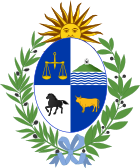 |
|---|
A constitutional referendum was held in Uruguay on 16 December 1951. [1] The proposed amendments to the constitution were approved by 54% of voters.
 |
|---|
A constitutional referendum was held in Uruguay on 16 December 1951. [1] The proposed amendments to the constitution were approved by 54% of voters.
The proposed changes to the constitution were presented to the General Assembly on 30 June 1951. The Chamber of Deputies approved it by a vote of 85 to 14 on 10 October, whilst the Senate approved it by a vote of 26 to 4 on 26 October. [1]
The amendments would: [1]
| Choice | Votes | % |
|---|---|---|
| For | 232,076 | 54.00 |
| Against | 197,684 | 46.00 |
| Total | 429,760 | 100 |
| Registered voters/turnout | 1,158,939 | 37.08 |
| Source: Direct Democracy | ||
The colegiado system was reintroduced prior to the 1954 general elections.